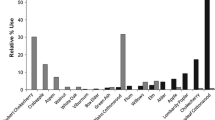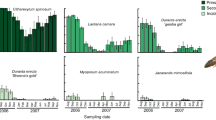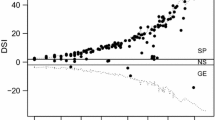Summary
Host plant preferences for 34 insect herbivore species are reported. Most polyphagous herbivores feeding on annuals, herbaceous perennials, and woody perennials show distinct preferences for the least abundant plant species among their various host plants. In addition, some populations of widely distributed polyphagous species are much more specialized in their diet than host plant lists alone would suggest. The high level of polyphagy on annuals and herbaceous perennials is suggested to be strongly influenced by the unpredictability of the host plant that is, in turn, controlled by environmental variability. Oligophagous herbivores preferred the least abundant woody perennials on the study sites. Ten of the 22 monophagous herbivores preferred the rarest of all the plant species on the same sites.
Similar content being viewed by others
References
Banfill J, Brusven M (1973) Food habits and ecology of grasshoppers in the Devils Mountains and Salmon River Breaks of Idaho. Melanderia 12:1–18
Beatley J (1976) Rainfall and fluctuating plant populations in relation to distributions and numbers of desert rodents in Southern Nevada. Oecologia (Berl) 24:21–42
Bland R (1976) Effect of parasites and food plants on the stability of a population of Melanoplus femurrubrum. Envir Ent 5:724–728
Cates RG (1980) Feeding patterns of monophagous, oligophagous, and polyphagous insect herbivores: The effect of resource abundance and plant chemistry. Oecologia (Berl) 46:22–31
Cates RG, Alexander H (1981) Host resistance and susceptibility. In: Bark Beetles in North American Conifers: Ecology and Evolution J Mitton and K Sturgeon (eds), University of Texas Press, Austin, Texas: in press
Cates RG, Rhoades D (1977a) Patterns in the production of antiherbivore chemical defenses in plant communities. Biochem Syst Ecol 5:185–193
Cates RG, Rhoades D (1977b) Prosopis leaves as a resource for insects. In: B Simpson (ed), Mesquite: Its biology in two desert scrub ecosystems. US/IBP Synthesis Series 4, Dowden, Hutchingson and Ross, Inc, Stroudsburg, Penn.: p 61–83
Feeny P (1976) Plant apparency and chemical defense. In: J Wallace and R Mansell (eds), Biochemical interaction between plants and insects, Rec Adv Phytochem 10:1–40, Plenum Press, New York-London
Futuyma D, Gould F (1979) Associations of plants and insects in a deciduous forest. Ecol Monogr 49:33–50
Gangwere S (1965) Food selection in the Oedipodine Grasshopper Arphia sulphurea (Babricius). Amer Midl Natur 74:67–75
Joern A (1979) Feeding patterns in grasshoppers (Orthoptera: Acrididae): Factors influencing diet specialization. Oecologia (Berl) 38:325–347
Lawton J, McNeil S (1979) Between the devil and the deep blue sea: On the problem of being an herbivore. In: R Anderson, L Taylor, B Turner (eds), Population dynamics, Blackwell Scientific, Oxford
Mitchell J (1975) Variation in food preferences of three grasshopper species (Acrididae: Orthoptera) as a function of food availability. Amer Midl Natur 94:267–283
Rathcke B (1976) Insect-plant patterns and relationships in the stemboring guild. Amer Midl Natur 96:98–117
Rhoades D, Cates RG (1976) Toward a general theory of plant antiherbivore chemistry. In: Biochemical interactions between plants and insects (J Wallace, R Mansell, eds). Rec Adv Phytochem 10:168–213. Plenum Press, New York-London
Rosenthal G, Janzen D (1979) Herbivores: Their interaction with secondary plant metabolites. Academic Press, New York-London
Scriber J, Feeny P (1979) Growth of herbivorous caterpillars in relation to feeding specialization and to the growth form of their food plants. Ecology 60:829–850
Shreve F (1951) Vegetation of the Sonoran Desert. Volume 1. Washington, DC. Carnegie Institution of Washington Publication 591
Ueckert D, Hansen R (1971) Dietary overlap of grasshoppers on sandhill rangeland in Northeastern Colorado. Oecologia (Berl) 8:276–295
Author information
Authors and Affiliations
Rights and permissions
About this article
Cite this article
Cates, R.G. Host plant predictability and the feeding patterns of monophagous, oligophagous, and polyphagous insect herbivores. Oecologia 48, 319–326 (1981). https://doi.org/10.1007/BF00346488
Received:
Issue Date:
DOI: https://doi.org/10.1007/BF00346488




